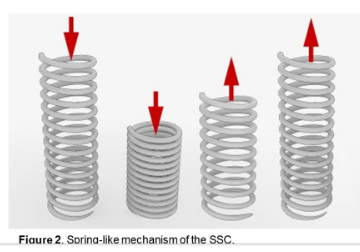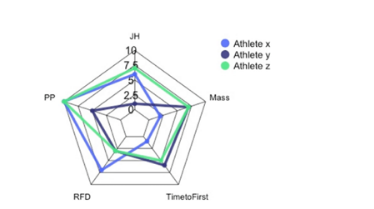| Category | Assignment | Subject | Education |
|---|---|---|---|
| University | Atlantic Technological University | Module Title | SE102-4-SP Biomechanics Sport |
A key sporting skill is the ability to produce maximal force to jump as high as possible. In this coursework, you will be analysing two different jump techniques (squat jump and countermovement jump) to determine which produces the greater height. This coursework is a comparison of the two techniques and will be written as a lab report. It must contain the following sections:
Keep the title short and concise, no more than twelve words. The title should capture the aim of the practical.
Give an introduction to key terms including an explanation as to why it is useful to be able to maximise jump height in sport. Give a background of the sport movement you are interested in and how this relates to the performance in your sport. Include aim/hypothesis of study (H0 and H1 format).
Your methodology is complete if someone else could repeat the experiment in the same way that you carried it out.
Either as tabular or graphical format. Must include a short note of points of interest. Do give the means and standard deviation of data that are reported. Do not discuss the results in this section.
All of the data for this coursework have been stored in a class spreadsheet in eportobello. Your coursework must be written based on the data from the whole class.
Explanation of results. Assume that the reader has knowledge of the area but is not an expert. The explanation should make reference to the information provided in the introduction, particularly the hypothesis. Any interpretation of the results should refer to the findings of previous investigations in the area. It is often necessary to include further references to support points that you are attempting to make.
As with the introduction your discussion should lead your reader through the discussion in a logical order. It may be helpful to start by discussing the participant group and how the group relates to the participants in previous studies.
Remember, the key focus of this study is to examine any effect SSC has on jump height when comparing a squat jump with a countermovement jump.
Summarise study, relating the main findings to the aims of the study and the hypothesis.
Full references must be given for any factual information, statements, quotes, diagrams or data that have been reported or reproduced, either partially or in full. Reference style to be used is Harvard format.
(See Marking Scheme for details)
Are You Looking for Answer of SE102-4-SP Assignment
Order Non Plagiarized AssignmentThe report should be 2000 +/-200 words in length. It is possible to roughly proportion the word count of each section according to the percentage of marks each attracts. The Introduction attracts 10% of the marks and should, therefore, consist of around 200 words. The discussion, however, is worth 30% of the marks and, accordingly, should consist of around 600 words.
The report should be written in the third person past tense. Example: “The cycle ergometer was set up to suit the subject.” – and not – “I set up the cycle ergometer to suit the subject.”
A key sporting skill is the ability to produce maximal force to jump as high as possible. In this coursework, you will be analysing two different jump techniques (squat jump and countermovement jump) to determine which produces the greater height. This coursework is a comparison of the two techniques and will be written as a lab report. It must contain the following sections:
Human movement is rarely an isolated form of muscle contraction but rather a pairing of eccentric and concentric contractions (Komi, 2000). The stretch shortening cycle (SSC) occurs when a concentric contraction is immediately preceded by an eccentric contraction (Komi, 1984). The stretching of the active muscle allows for a more forceful concentric contraction. Examples of the SSC in everyday human movement are walking, running and jumping.
Efficient SSC produces higher forces at any given velocity (thus increasing jump height) (Flanagan and Commyns, 2008) and results in a reduced metabolic cost of movement, compared to an isolated concentric contraction (Cavagna et al., 1968). More force can be generated from the SSC mechanism the quicker the shortening occurs after the stretching of the muscle (Cavagna et al., 1968).
The release of stored potential elastic energy (EE) in the muscle complex (Cavagna et al., 1965), increased excitability of proprioceptors (Flanagan and Commyns, 2008), and the length of the muscle being closer to optimal (Turner and Jeffreys, 2010) are all proposed mechanisms of the performance enhancement involved with the SSC. The tendon is the primary site for EE storage and how much it stores is proportional to its deformation (which is a function of tendon stiffness) and the force applied. Higher levels of muscle stiffness increases the amount of stored and reused EE (Turner and Jeffreys, 2010). Muscle spindle excitability may increase recruitment of motor units and/or increased rate of firing of preciously recruited units during the eccentric contraction leading to force potentiation of the concentric contraction. Increased SSC efficiency leads to the possible reduction of the inhibitory effects of the golgi-tendon organ (GTO) that inhibits the pre-concentric contraction (Turner and Jeffreys, 2010).


The aim of this lab is to measure jump height and further metrics of both the CMJ and SJ. A comparison of key metrics will provide further insight into both jump methods to better inform athlete training in the future.
Buy Answer of This Assignment & Raise Your Grades
Request to Buy AnswerSubjects were given coaching cues for each of the two jumps and two familiarisation trials on each jump prior to recording of data. The equipment used was a Vald performance force plate (ForceDecks | Dual Force Plate System | VALD Performance). Two subjects were tested at a time with one performing a jump and another undertaking the minimum rest time between jumps, of sixty seconds. The two participants undergoing testing were warmed up immediately prior, with a standardised warm-up consisting of 10 lunges (5 on each leg), calf stretching (alternating legs), 5 bodyweight squats and 5 jump squats. Subjects were given correct coaching cues and two familiarisation trials for each of the three jumps, immediately before testing. Subjects then performed each trial jump at maximum effort and with their hands on their hips. The force-time data from the force plate was transferred to a computer and the subsequent graphs were analysed to find body weight (BW), max ground reaction force (GRF), rate of force development (ROFD), time to reach max GRF, flight time, jump height, slow SSC performance and fast SSC performance and contact time for the drop jumps. From this we were able to analysis and compare the SSC function of the 6 subjects.
| Subject | Age (year) | Gender | Height (m) | Weight (kg) | Sporting Background |
|---|---|---|---|---|---|
| 1 | 20 | Male | 1.805 | 81.0 | Rugby |
| 2 | 21 | Male | 1.735 | 79.1 | Football |
| 3 | 21 | Male | 1.835 | 80.5 | Hurling & Rugby |
| 4 | 20 | Male | 1.765 | 80.8 | Rugby |
| 5 | 19 | Female | 1.775 | 68.4 | Dancing |
| 6 | 20 | Female | 1.625 | 67.5 | Athletics |
| Subject | BW (N) | GRFmax (N) | Flight Time (s) | Jump Height(m) |
|---|---|---|---|---|
| 1 | 79.79 | 468.63 | 1.0045 | 0.618 |
| 2 | 107.57 | 433.50 | 0.8005 | 0.393 |
| 3 | 115.57 | 464.54 | 0.783 | 0.375 |
| 4 | 115.31 | 451.41 | 0.7735 | 0.367 |
| 5 | 111.87 | 339.96 | 0.6415 | 0.252 |
| 6 | 106.96 | 395.82 | 0.823 | 0.388 |
Table 4: Counter-movement jump means

Keep the title short and concise, no more than twelve words. The title should capture the aim of the practical.
Give an introduction to key terms including an explanation as to why it is useful to be able to maximise jump height in sport. Give a background of the sport movement you are interested in and how this relates to the performance in your sport. Include aim/hypothesis of study (H0 and H1 format).
Your methodology is complete if someone else could repeat the experiment in the same way that you carried it out.
Either as tabular or graphical format. Must include a short note of points of interest. Do give the means and standard deviation of data that are reported (this can be done through excel functions). Do not discuss the results in this section.
Explanation of results. Assume that the reader has knowledge of the area but is not an expert. The explanation should make reference to the information provided in the introduction, particularly the hypothesis. Any interpretation of the results should refer to the findings of previous investigations in the area. It is often necessary to include further references to support points that you are attempting to make.
As with the introduction your discussion should lead your reader through the discussion in a logical order. It may be helpful to start by discussing the participant group and how the group relates to the participants in previous studies.
Remember, the key focus of this study is to examine any effect SSC has on jump height when comparing a squat jump with a countermovement jump.
Summarise study, relating the main findings to the aims of the study and the hypothesis.
Full references must be given for any factual information, statements, quotes, diagrams or data that have been reported or reproduced, either partially or in full. Reference style to be used is Harvard format.
(See Marking Scheme for details)
The report should be 2000 +/-200 words in length. It is possible to roughly proportion the word count of each section according to the percentage of marks each attracts. The Introduction attracts 10% of the marks and should, therefore, consist of around 200 words. The discussion, however, is worth 30% of the marks and, accordingly, should consist of around 600 words.
The report should be written in the third person past tense. Example: “The cycle ergometer was set up to suit the subject.” – and not – “I set up the cycle ergometer to suit the subject.”
Countermovement Jump or Squat Jump? (hawkindynamics.com)
Readings on eportobello
Achieve Higher Grades SE102-4-SP Assignment
Order Non Plagiarized AssignmentAre you trying to find someone who can help with my SE102-4-SP Jump Technique Comparison Assignment Report? Well! You're in the right place, our podium, Workingment, provides Report Writing Service. Our well-researched and talented professors can also provide you with odd assignments. Suppose you're judging whether to Write My Assignment with our professors. No doubt! Our team can help with your assignment. We also provide Free Sample assignments for your guidance. Get in touch right now!
Hire Assignment Helper Today!
Let's Book Your Work with Our Expert and Get High-Quality Content
